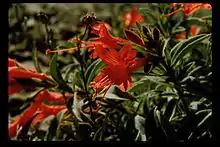Epilobium septentrionale
Epilobium septentrionale, with the common names Humboldt County fuchsia and northern willowherb, is a species of willowherb. Like the wildflower zauschneria, this plant was once treated as a member of genus Zauschneria but has more recently been placed with the willowherbs.
| Epilobium septentrionale | |
|---|---|
 | |
| Scientific classification | |
| Kingdom: | Plantae |
| Clade: | Tracheophytes |
| Clade: | Angiosperms |
| Clade: | Eudicots |
| Clade: | Rosids |
| Order: | Myrtales |
| Family: | Onagraceae |
| Genus: | Epilobium |
| Species: | E. septentrionale |
| Binomial name | |
| Epilobium septentrionale (D.D.Keck) R.N.Bowman & Hoch | |
| Synonyms | |
|
Zauschneria septentrionalis | |
Distribution
This species is endemic to Northern California, where it is an uncommon resident of the rocky ledges of the Northern Outer California Coast Ranges.[1]
Description
Epilobium septentrionale is a squat, clumpy perennial growing in thin patches of soil between rocks and sending up a few erect stems. The leaves are oval and pointed, glandular, and covered in a coat of white fuzz.
At the end of each erect branch is a glandular inflorescence bearing a bright red-orange tubular flower 2 or 3 centimeters long. A bunch of stamens and one long pistil protrude obviously from the mouth of the bloom, which is pollinated by nectar-feeding birds. The fruit is a hairy capsule about two centimeters long.